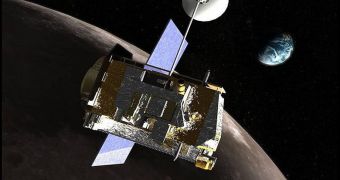As amateur and professional skywatchers and astronomers around the world are preparing to observe tomorrow night' long-duration lunar eclipse, NASA too is gearing up for its own observations session. It will be using the Lunar Reconnaissance Orbiter (LRO) for the job.
The spacecraft has been in orbit around the Moon since 2009, and has downlinked important datasets related to lunar topography and resources. The orbiter is also tasked with finding an appropriate landing site for future manned missions to Earth's natural satellite.
Now, the spacecraft is being prepared for yet another important photo shoot. This time, it will image the Moon as it is passing directly through Earth's shadow. Due to its position, in a 30-by-216 kilometer orbit, the probe will most likely make spectacular observations.
According to Noah Petro, it will have a “front-row seat” to the entire show. Petro is an associate project scientist for the LRO mission, and is based at the NASA Goddard Space Flight Center (GSFC), in Greenbelt, Maryland.
On Wednesday, June 15, the Moon will pass exactly through the center of the shadow our planet casts, and become obscured for more than 100 minutes. This is fairly impressive, considering that the maximum length of a lunar eclipse is 107 minutes.
The event takes place just two weeks after another important astronomical milestone, the June 1 partial solar eclipse. The latter was only visible from Arctic regions, and appeared as if the Moon was blocking out a part of the solar disk.
Observations of the new lunar eclipse will be the clearest in the Eastern Hemisphere. For people living in North and South America, the event will not be visible, due to the fact that it will be daylight when the Moon will pass through Earth's shadow.
Though North and Central America cannot participate in the fun, the “LRO will be observing, so eventually everyone will get to see a close-up of it,” Petro says.
Most of Europe will get to see the eclipse for a little while during the rise of the Moon, whereas most of Easter Asia (East China, Japan, Australia, New Zealand, etc.) will see the event when the Moon sets.
The regions in between, including central and southern Africa, the island of Madagascar, the Near and Middle East, the Indian subcontinent, and parts of Russia, China and Oceania will have the best vantage points for observing the eclipse.
As the eclipse takes place, the Moon will become between 10,000 and 100,000 times dimmer than it usually is. If observed from dark locations, it will appear three-dimensional and huge in the night sky.
The event will begin at roughly 17:24 Universal Time (UT), and will reach its darkest point between 19:22 UT and 21:02 UT. The astronomical end of the eclipse is at 23:00 UT.

 14 DAY TRIAL //
14 DAY TRIAL //